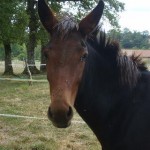The Best of Both Worlds
Mules are a hybrid species. They result from the breeding of a female horse or pony and a male donkey.* Mules are considered to exhibit “hybrid vigour”, meaning that they display the best qualities of their genetic mix. Thus, mules have the strength, size, and vigour of the horse, combined with the stamina, sure-footedness, intelligence, and stoic nature of the donkey.

They can be a rewarding working and pleasure animal. A well-trained mule can be very dependable, calm, and steady, traits that explain their successful use by armed forces to carry explosives and ammunition during both world wars, as well as many other armed conflicts before and since. They were champion athletes in ancient Greece, where mule racing became part of the Olympics in 500B.C. Mules have long been very popular in the United States, where they compete in events as diverse as reining, cutting, endurance, dressage, show jumping, pleasure (Eastern, Western, side-saddle) and halter classes-and more. Mules excel at driving, and can also be used as pack animals or for draught work on smallholdings. Their unflappable nature and sure-footedness make them the popular choice to guide and carry hundreds of tourists to the floor of the Grand Canyon.
As with their donkey fathers, mules have an undeserved reputation for stubbornness. Having inherited the donkey’s intelligence and instinct for self-preservation, mules simply tend to avoid putting themselves in danger or being over worked. What can appear as stubbornness, may actually be fear or confusion.
Mules are intelligent and learn quickly. But they can learn equally from both bad and good experiences and training. It is important to understand the nature and behaviour of the mule, so that you realize the importance of sensitivity, consistency, patience, and calm when training. When properly trained, a mule is loyal, obliging, tolerant, affectionate and calm.
Because of their hybrid vigour, mules tend to be more resistant to ailments than their parents. They can, however, suffer from the same illness and disease, and so need the same level of care and attention that donkeys and horses need. (See donkey husbandry section and references). However, there are some additional things to remember when caring for a mule:
Long periods of stabling are not advised. Intelligent and sensitive by nature, mules need to be out in the pasture or paddock with the companionship of other mules (or equines). Care needs to be taken that they are kept active and mentally stimulated.
Mules can be fed on grass hay and barley straw like donkeys, and have the same requirement for fresh water as do horses and donkeys. Feeding requirements depend upon the size and weight of the individual mule; they can require a somewhat smaller ration than a similar sized horse.
Remember: like donkeys and horses, mules will need their hooves trimmed by an experienced, gentle, and patient farrier every 6-10 weeks.
* A hinny is the result of breeding between a male horse and a female donkey and are less common than mules.
Thank you to Diane Lindsay for producing this overview for us.

